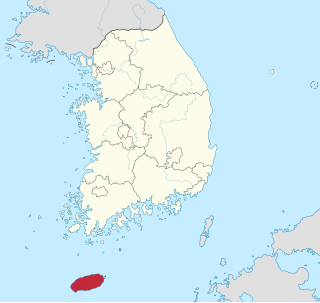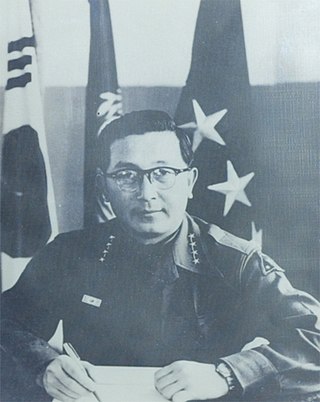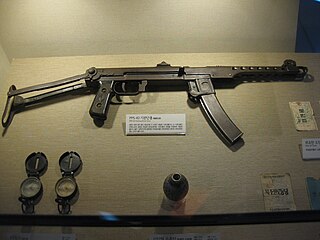
The Korean War was fought between North Korea and South Korea from 1950 to 1953. It began on 25 June 1950 when North Korea invaded South Korea and ceased after an armistice on 27 July 1953. North Korea was supported by China and the Soviet Union while South Korea was supported by the United States and US-led United Nations Command (UN) forces.
The history of North Korea began with the end of World War II in 1945. The surrender of Japan led to the division of Korea at the 38th parallel, with the Soviet Union occupying the north, and the United States occupying the south. The Soviet Union and the United States failed to agree on a way to unify the country, and in 1948, they established two separate governments – the Soviet-aligned Democratic People's Republic of Korea and the American-aligned Republic of Korea – each claiming to be the legitimate government of all of Korea.

The division of Korea began on August 15, 1945 when the official announcement of the surrender of Japan was released, thus ending the Pacific Theater of World War II. During the war, the Allied leaders had already been considering the question of Korea's future following Japan's eventual surrender in the war. The leaders reached an understanding that Korea would be liberated from Japan but would be placed under an international trusteeship until the Koreans would be deemed ready for self-rule. In the last days of the war, the United States proposed dividing the Korean peninsula into two occupation zones with the 38th parallel as the dividing line. The Soviets accepted their proposal and agreed to divide Korea.

The Jeju uprising, known in South Korea as the Jeju April 3 incident, was an uprising on Jeju Island from April 1948 to May 1949. A year prior to its start, residents of Jeju had begun protesting elections scheduled by the United Nations Temporary Commission on Korea (UNTCOK) to be held in the United States-occupied half of Korea, which they believed would entrench the division of the country. A general strike was later organised by the Workers' Party of South Korea (WPSK) from February to March 1948. The WPSK launched an insurgency in April 1948, attacking police and Northwest Youth League members stationed on Jeju who had been mobilized to suppress the protests by force. The First Republic of Korea under President Syngman Rhee escalated the suppression of the uprising from August 1948, declaring martial law in November and beginning an "eradication campaign" against rebel forces in the rural areas of Jeju in March 1949, defeating them within two months. Many rebel veterans and suspected sympathizers were later killed upon the outbreak of the Korean War in June 1950, and the existence of the Jeju uprising was officially censored and repressed in South Korea for several decades.

The Soviet invasion of Manchuria, formally known as the Manchurian Strategic Offensive Operation or simply the Manchurian Operation, began on 9 August 1945 with the Soviet invasion of the Japanese puppet state of Manchukuo. It was the largest campaign of the 1945 Soviet–Japanese War, which resumed hostilities between the Union of Soviet Socialist Republics and the Empire of Japan after almost six years of peace.

The People's Volunteer Army (PVA), officially the Chinese People's Volunteers (CPV), was the armed expeditionary forces deployed by the People's Republic of China during the Korean War. Although all units in the PVA were actually transferred from the People's Liberation Army under the orders of Chairman Mao Zedong, the PVA was separately constituted in order to prevent an official war with the United States. The PVA entered Korea on 19 October 1950 and completely withdrew by October 1958. The nominal commander and political commissar of the PVA was Peng Dehuai before the ceasefire agreement in 1953, although both Chen Geng and Deng Hua served as the acting commander and commissar after April 1952 following Peng's illness. The initial units in the PVA included 38th, 39th, 40th, 42nd, 50th, 66th Corps; totalling 250,000 men. About 3 million Chinese civilian and military personnel had served in Korea throughout the war.

Operation Ripper, also known as the Fourth Battle of Seoul, was a United Nations (UN) military operation conceived by the US Eighth Army, General Matthew Ridgway, during the Korean War. The operation was intended to destroy as much as possible of the Chinese People's Volunteer Army (PVA) and Korean People's Army (KPA) forces around Seoul and the towns of Hongch'on, 50 miles (80 km) east of Seoul, and Chuncheon, 15 miles (24 km) further north. The operation also aimed to bring UN troops to the 38th Parallel. It followed upon the heels of Operation Killer, an eight-day UN offensive that concluded February 28, to push PVA/KPA forces north of the Han River. The operation was launched on 6 March 1951 with US I Corps and IX Corps on the west near Seoul and Hoengsong and US X Corps and Republic of Korea Army (ROK) III Corps in the east, to reach the Idaho Line, an arc with its apex just south of the 38th Parallel in South Korea.

The Korean DMZ Conflict, also referred to as the Second Korean War by some, was a series of low-level armed clashes between North Korean forces and the forces of South Korea and the United States, largely occurring between 1966 and 1969 along the Korean Demilitarized Zone (DMZ).

Chung Il-kwon was a South Korean politician, diplomat, and soldier. A general in the Republic of Korea Army, he served as Foreign Minister 1963 to 1964, and Prime Minister from 1964 to 1970. He was an ally of President Park Chung Hee.

Australia entered the Korean War on 28 September, 1950; following the invasion of South Korea by North Korea. The war's origins began after Japan's defeat in World War II, which heralded the end to 35 years of Japanese occupation of the Korean Peninsula. The surrender of Japan to the Allied forces on 2 September 1945, led to the division of Korea into two countries, which were officially called the Democratic People's Republic of Korea (DPRK) and the Republic of Korea (ROK), with the DPRK being occupied by the Soviet Union, and the ROK, below the 38th Parallel, being occupied by the United States (US).
Yoon Byung-in, also known in English reference as Byung-in Yoon, was a Korean Grandmaster of martial arts. He is believed to be the first Korean national to study Chuan Fa in China and to return to teach it in Korea. He was an influential instructor to many current and past Masters and Grandmasters, and himself a master of many styles and studies of Martial Arts.

The First and Second Battles of Wonju, also known as the Wonju Campaign or the Third Phase Campaign Eastern Sector, was a series of engagements between North Korean and United Nations (UN) forces during the Korean War. The battle took place from December 31, 1950, to January 20, 1951, around the South Korean town of Wonju. In coordination with the Chinese capture of Seoul on the western front, the North Korean Korean People's Army (KPA) attempted to capture Wonju in an effort to destabilize the UN defenses along the central and the eastern fronts.

The Korean Armistice Agreement is an armistice that brought about a cessation of hostilities of the Korean War. It was signed by United States Army Lieutenant General William Harrison Jr. and General Mark W. Clark representing the United Nations Command (UNC), North Korea leader Kim Il Sung and General Nam Il representing the Korean People's Army (KPA), and Peng Dehuai representing the Chinese People's Volunteer Army (PVA). The armistice was signed on 27 July 1953, and was designed to "ensure a complete cessation of hostilities and of all acts of armed force in Korea until a final peaceful settlement is achieved."
Operation Pokpung was the military invasion of the Republic of Korea (ROK) by the Democratic People's Republic of Korea (DPRK) that triggered the Korean War. The DPRK military began the offensive by crossing the 38th parallel north and entering ROK territory at 04:00 PYT/KST on 25 June 1950; the DPRK government did not issue any declaration of war before the invasion.
Events from the year 1948 in South Korea.

The People's Committees were a type of largely local committee-government which appeared throughout Korea immediately following the conclusion of the Second World War. These committees existed in their original form from August 1945 to early 1946. By 1948, these participatory grassroots organs of self-government became centralized in the north and purged in the south.
Operation Rat Killer was a Korean War operation carried out by Republic of Korea forces and United States advisers from December 1951 into February 1952. It was aimed at eradicating communist guerrilla forces operating in zones occupied by the United Nations forces. The operation involved two Korean Army divisions, the Capital Division and the 8th Division, several regiments of the Korean National Police, a ROKAF squadron of Mustang fighter-bombers, and about sixty United States experts. The operation was under the command of General Paik Sun Yup. The operation's particular priority was the mountainous area of Jirisan.
The Korean War started when North Korea invaded South Korea, and ended on July 27, 1953, with the armistice creating the well-known Korean Demilitarized Zone.

The Ulchin-Samcheok landings was an unsuccessful attempt by North Korea to establish guerrilla camps in the Taebaek Mountains on October 30, 1968, in order to topple Park Chung-hee's regime and bring about the reunification of Korea.
The UN offensive into North Korea was a large-scale offensive in late 1950 by United Nations (UN) forces against North Korean forces during the Korean War.












